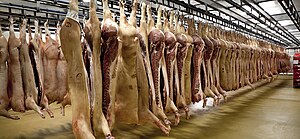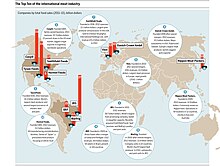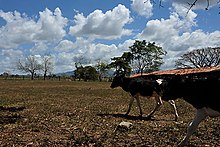Meat industry
The meat industry are the people and companies engaged in modern industrialized livestock agriculture for the production, packing, preservation and marketing of meat (in contrast to dairy products, wool, etc.). In economics, the meat industry is a fusion of primary (agriculture) and secondary (industry) activity and hard to characterize strictly in terms of either one alone. The greater part of the meat industry is the meat packing industry – the segment that handles the slaughtering, processing, packaging, and distribution of animals such as poultry, cattle, pigs, sheep and other livestock.

A great portion of the ever-growing[1] meat branch in the food industry involves intensive animal farming in which livestock are kept almost entirely indoors[2] or in restricted outdoor settings like pens. Many aspects of the raising of animals for meat have become industrialized, even many practices more associated with smaller family farms, e.g. gourmet foods such as foie gras.[3][4] The production of livestock is a heavily vertically integrated industry where the majority of supply chain stages are integrated and owned by one company.[citation needed]
Efficiency considerations
[edit]The livestock industry uses more land than any other human activity and is one of the largest contributors to water pollution and greenhouse gas emissions. A relevant factor is the produced species' feed conversion efficiency. Taking into account other concerns, like the use of energy, pesticides, land, and nonrenewable resources, beef, lamb, goat, and bison as sources of red meat show the worst efficiency; poultry and eggs come out best.[5]
Meat sources
[edit]| type | 1999 | 2000 | 2012 | % change 1990–2012 |
|---|---|---|---|---|
| Cattle and Buffaloes | 1445 | 1465 | 1684 | 16.5 |
| Pigs | 849 | 856 | 966 | 13.8 |
| Poultry | 11788 | 16077 | 24075 | 104.2 |
| Sheep and Goats | 1795 | 1811 | 2165 | 20.6 |
Global production of meat products
[edit]
Companies
[edit]Among the largest meat producers worldwide are:
World beef production
[edit]| Country | million tonnes (2017) | % Of World |
|---|---|---|
| United States | 11.91 | |
| Brazil | 9.55 | |
| China | 6.90 | |
| Argentina | 2.84 | |
| Australia | 2.05 | |
| Mexico | 1.93 | |
| Russia | 1.61 | |
| France | 1.42 | |
| Germany | 1.14 | |
| South Africa | 1.01 | |
| Turkey | 0.99 |
Criticism
[edit]Criticized aspects and effects of industrial meat production include:
- Hormone treatment such as steroids and the effect of consuming meat from animals raised with these on human consumers (see also Beef hormone controversy)[9]
- Spread of animal diseases, e.g. mad-cow disease (BSE), avian flu, swine influenza (H1N1), avian influenza (H5N1), foot-and-mouth disease,[1] including to human consumers
- The commonness of cruelty to animals in the meat industry
- Certain animal rights advocates and groups believe that the production of meat is unethical[10] and the industry should be abolished[11]
- Contribution of the overconsumption of meat products to obesity
- Spread of human disease associated with animal waste, e.g. through E. coli
- Cost of state services associated with the above, including meat inspection and health care
- Spread of human disease associated with workers in meat and poultry processing facilities[12]
- The ecological footprint of the meat industry, including the raising of feed and animal waste disposal
- Heavy use of groundwater for feeding animals

Aftermath of deforestation processes due to cattle ranching purposes in the region of Honduras - Deforestation, extinction and other species loss especially in the Amazon region or other places where beef cattle are raised in what was formerly rainforested land
- Climate change via greenhouse gases generated by the meat industry is significantly greater than growing and processing fruits and vegetables. The largest agricultural methane source on the planet is livestock. Global greenhouse gas emissions from animal-based foods are twice those of plant-based foods.[13]
- Heavy use of groundwater for feeding animals
Many observers[who?] suggest that the expense of dealing with the above is grossly underestimated by present economic metrics and that true cost accounting would drastically raise the price[14] of industrial meat.[15][16][17][18]
Effects on livestock workers
[edit]American slaughterhouse workers are three times more likely to suffer serious injury than the average American worker.[19] NPR reports that pig and cattle slaughterhouse workers are nearly seven times more likely to suffer repetitive strain injuries than average.[20] The Guardian reports that, on average, there are two amputations a week involving slaughterhouse workers in the United States.[21] On average, one employee of Tyson Foods, the largest meat producer in America, is injured and amputates a finger or limb per month.[22] The Bureau of Investigative Journalism reported that over a period of six years, in the UK 78 slaughter workers lost fingers, parts of fingers or limbs, more than 800 workers had serious injuries, and at least 4,500 had to take more than three days off after accidents.[23] In a 2018 study in the Italian Journal of Food Safety, slaughterhouse workers are instructed to wear ear protectors to protect their hearing from the constant screams of animals being killed.[24] A 2004 study in the Journal of Occupational and Environmental Medicine found that "excess risks were observed for mortality from all causes, all cancers, and lung cancer" in workers employed in the New Zealand meat processing industry.[25]
The worst thing, worse than the physical danger, is the emotional toll. If you work in the stick pit [where hogs are killed] for any period of time—that let's [sic] you kill things but doesn't let you care. You may look a hog in the eye that's walking around in the blood pit with you and think, 'God, that really isn't a bad looking animal.' You may want to pet it. Pigs down on the kill floor have come up to nuzzle me like a puppy. Two minutes later I had to kill them – beat them to death with a pipe. I can't care.
— Gail A. Eisnitz, [26]
The act of slaughtering animals, or of raising or transporting animals for slaughter, may engender psychological stress or trauma in the people involved.[27][28][20][29][30][31][32][33][34][35][36] A 2016 study in Organization indicates, "Regression analyses of data from 10,605 Danish workers across 44 occupations suggest that slaughterhouse workers consistently experience lower physical and psychological well-being along with increased incidences of negative coping behavior."[37] A 2009 study by criminologist Amy Fitzgerald indicates, "slaughterhouse employment increases total arrest rates, arrests for violent crimes, arrests for rape, and arrests for other sex offenses in comparison with other industries."[37] As authors from the PTSD Journal explain, "These employees are hired to kill animals, such as pigs and cows, that are largely gentle creatures. Carrying out this action requires workers to disconnect from what they are doing and from the creature standing before them. This emotional dissonance can lead to consequences such as domestic violence, social withdrawal, anxiety, drug and alcohol abuse, and PTSD."[38]
Slaughterhouses in the United States commonly illegally employ and exploit underage workers and illegal immigrants.[39][40] In 2010, Human Rights Watch described slaughterhouse line work in the United States as a human rights crime.[41] In a report by Oxfam America, slaughterhouse workers were observed not being allowed breaks, were often required to wear diapers, and were paid below minimum wage.[42]
Possible alternatives
[edit]Cultured meat (aka "clean meat") potentially offers some advantages in terms of efficiency of resource use and animal welfare. It is, however, still at an early stage of development and its advantages are still contested.[citation needed]
Alternative meat industry
[edit]A growing trend towards vegetarian or vegan diets and the Slow Food movement are indicators of a changing consumer conscience in western countries. Producers on the other hand have reacted to consumer concerns by slowly shifting towards ecological or organic farming. The Alternative meat industry is projected to be worth 140 billion in the next 10 years.[43]
See also
[edit]- Agricultural engineering
- Agricultural robot
- Dairy industry in the United Kingdom
- Dairy industry in the United States
- Dairy industry
- Golden Triangle of Meat-packing
- Grinder-mixer
- ICT in agriculture
- Leather
- List of largest meat companies in Germany
- Meat Industry Workers Federation
- Meat market
- North American Meat Institute (NAMI)
- Pink slime, white slime
- Poultry industry
- Red meat
- Rendering (animal products)
- Slaughterhouse
- World Beef Report
References
[edit]- ^ a b "Global Meat Production and Consumption Continue to Rise". Worldwatch Institute. Archived from the original on 24 January 2013. Retrieved 30 June 2015.
- ^ Paul Ebner. "Modern Livestock Facilities". Purdue University. Archived from the original on 22 May 2018. Retrieved 1 March 2016.
- ^ "Foie Gras: Cruelty to Ducks and Geese | Ducks and Geese Used for Food | Factory Farming: Misery for Animals | The Issues". PETA. 21 June 2010. Retrieved 16 January 2017.
- ^ "An Animal Equality investigation". Foie Gras farms. Retrieved 16 January 2017.
- ^ Nina Rastogi (28 April 2009). "The Kindest Cut – Which meat harms our planet the least?". Slate.com. Retrieved 16 January 2017.
- ^ "FAO's Animal Production and Health Division: Meat & Meat Products". Fao.org. Retrieved 16 January 2017.
- ^ "FAOSTAT". www.fao.org. Retrieved 18 October 2019.
- ^ "World Beef Production: Ranking Of Countries". Beef2live.com. 30 December 2016. Archived from the original on 16 November 2015. Retrieved 16 January 2017.
- ^ "Steroid Hormone Implants Used for Growth in Food-Producing Animals". FAO. 2015.
- ^ "Definition of veganism". The Vegan Society. Retrieved 6 June 2018.
- ^ "The Six Principles of the Abolitionist Approach to Animal Rights – Animal Rights The Abolitionist Approach". www.abolitionistapproach.com. Retrieved 6 June 2018.
- ^ Dyal, Jonathan W.; Grant, Michael P.; Broadwater, Kendra; Bjork, Adam; Waltenburg, Michelle A.; Gibbins, John D.; Hale, Christa; Silver, Maggie; Fischer, Marc; Steinberg, Jonathan; Basler, Colin A.; Jacobs, Jesica R.; Kennedy, Erin D.; Tomasi, Suzanne; Trout, Douglas; Hornsby-Myers, Jennifer; Oussayef, Nadia L.; Delaney, Lisa J.; Patel, Ketki; Shetty, Varun; Kline, Kelly E.; Schroeder, Betsy; Herlihy, Rachel K.; House, Jennifer; Jervis, Rachel; Clayton, Joshua L.; Ortbahn, Dustin; Austin, Connie; Berl, Erica; Moore, Zack; Buss, Bryan F.; Stover, Derry; Westergaard, Ryan; Pray, Ian; DeBolt, Meghan; Person, Amy; Gabel, Julie; Kittle, Theresa S.; Hendren, Pamela; Rhea, Charles; Holsinger, Caroline; Dunn, John; Turabelidze, George; Ahmed, Farah S.; deFijter, Siestke; Pedati, Caitlin S.; Rattay, Karyl; Smith, Erica E.; Luna-Pinto, Carolina; Cooley, Laura A.; Saydah, Sharon; Preacely, Nykiconia D.; Maddox, Ryan A.; Lundeen, Elizabeth; Goodwin, Bradley; Karpathy, Sandor E.; Griffing, Sean; Jenkins, Mary M.; Lowry, Garry; Schwarz, Rachel D.; Yoder, Jonathan; Peacock, Georgina; Walke, Henry T.; Rose, Dale A.; Honein, Margaret A. (8 May 2020). "COVID-19 Among Workers in Meat and Poultry Processing Facilities ― 19 States, April 2020". MMWR. Morbidity and Mortality Weekly Report. 69 (18). doi:10.15585/mmwr.mm6918e3. PMID 32379731. S2CID 218555116.
COVID-19 cases among U.S. workers in 115 meat and poultry processing facilities were reported by 19 states. Among approximately 130,000 workers at these facilities, 4,913 cases and 20 deaths occurred.
- ^ Xu, Xiaoming; Sharma, Prateek; Shu, Shijie; Lin, Tzu-Shun; Ciais, Philippe; Tubiello, Francesco N.; Smith, Pete; Campbell, Nelson; Jain, Atul K. (September 2021). "Global greenhouse gas emissions from animal-based foods are twice those of plant-based foods". Nature Food. 2 (9): 724–732. doi:10.1038/s43016-021-00358-x. hdl:2164/18207. PMID 37117472. S2CID 240562878.
- ^ "USDA ERS – Retail Meat Prices & Price Spreads". Ers.usda.gov. 2 December 2016. Archived from the original on 28 October 2016. Retrieved 16 January 2017.
- ^ "Food wastage footprint – Full cost accounting" (PDF). FAO. 2014.
- ^ "Unfair fare: Why prices for meat from small local farms are too high". Ethicurean.com. Archived from the original on 28 January 2017. Retrieved 16 January 2017.
- ^ "Getting Real About the High Price of Cheap Food". TIME. 2009.
- ^ "The Triple Whopper Environmental Impact of Global Meat Production". TIME. 2013.
- ^ "Meatpacking". Occupational Safety and Health Administration. Retrieved 23 May 2019.
- ^ a b Lowe, Peggy (11 August 2016). "Working 'The Chain,' Slaughterhouse Workers Face Lifelong Injuries". NPR.
- ^ "Two amputations a week: the cost of working in a US meat plant". The Guardian. 5 July 2018. Retrieved 23 May 2019.
- ^ Lewis, Cora (18 February 2018). "America's Largest Meat Producer Averages One Amputation Per Month". Buzzfeed News. Retrieved 23 May 2019.
- ^ "Revealed: Shocking safety record of UK meat plants". The Bureau of Investigative Journalism. 29 July 2018. Retrieved 23 May 2019.
- ^ Francesca Iulietto, Maria; Sechi, Paola (3 July 2018). "Noise assessment in slaughterhouses by means of a smartphone app". Italian Journal of Food Safety. 7 (2): 7053. doi:10.4081/ijfs.2018.7053. PMC 6036995. PMID 30046554.
- ^ McLean, D; Cheng, S (June 2004). "Mortality and cancer incidence in New Zealand meat workers". Journal of Occupational and Environmental Medicine. 61 (6): 541–547. doi:10.1136/oem.2003.010587. PMC 1763658. PMID 15150395.
- ^ Eisnitz, Gail A. (1997). Slaughterhouse: The Shocking Story of Greed, Neglect, and Inhumane Treatment Inside the U.S. Meat Industry. Prometheus Books. ISBN 978-1-57392-166-4.[page needed]
- ^ Sharman, Jon (30 January 2019). "Sheep farmer who felt so guilty about driving his lambs to slaughter rescues them and becomes a vegetarian". The Independent.
- ^ Victor, Karen; Barnard, Antoni (20 April 2016). "Slaughtering for a living: A hermeneutic phenomenological perspective on the well-being of slaughterhouse employees". International Journal of Qualitative Studies on Health and Well-being. 11: 30266. doi:10.3402/qhw.v11.30266. PMC 4841092. PMID 27104340.
- ^ "PTSD in the Slaughterhouse". The Texas Observer. 7 February 2012. Retrieved 30 January 2019.
- ^ Newkey-Burden, Chas (19 November 2018). "There's a Christmas crisis going on: no one wants to kill your dinner – Chas Newkey-Burden". The Guardian. Retrieved 30 January 2019.
- ^ "Psychological Distress Among Slaughterhouse Workers Warrants Further Study – SPH – Boston University". School of Public Health. Retrieved 30 January 2019.
- ^ Dillard, Jennifer (September 2007). "A Slaughterhouse Nightmare: Psychological Harm Suffered by Slaughterhouse Employees and the Possibility of Redress through Legal Reform". ResearchGate.net. Retrieved 30 January 2019.
- ^ S, Serina; hu (2 March 2018). "'I couldn't look them in the eye': Farmer who couldn't slaughter his cows is turning his farm vegan". Inews.co.uk. Retrieved 30 January 2019.
- ^ Fox, Katrina. "Meet The Former Livestock Agent Who Started An International Vegan Food Business". Forbes.com. Retrieved 30 January 2019.
- ^ Lebwohl, Michael (25 January 2016). "A Call to Action: Psychological Harm in Slaughterhouse Workers". The Yale Global Health Review. Retrieved 23 May 2019.
- ^ Nagesh, Ashitha (31 December 2017). "The harrowing psychological toll of slaughterhouse work". Metro. Retrieved 23 May 2019.
- ^ a b Baran, B. E.; Rogelberg, S. G.; Clausen, T (2016). "Routinized killing of animals: Going beyond dirty work and prestige to understand the well-being of slaughterhouse workers". Organization. 23 (3): 351–369. doi:10.1177/1350508416629456. S2CID 148368906.
- ^ "The Psychological Damage of Slaughterhouse Work". PTSDJournal. Retrieved 23 May 2019.
- ^ Waldman, Peter (29 December 2017). "America's Worst Graveyard Shift Is Grinding Up Workers". Bloomberg.com. Retrieved 23 May 2019.
- ^ Grabell, Michael (1 May 2017). "Exploitation and Abuse at the Chicken Plant". The New Yorker. Retrieved 23 May 2019.
- ^ Varia, Nisha (11 December 2010). "Rights on the Line". Human Rights Watch. Retrieved 23 May 2019.
- ^ Grabell, Michael (23 May 2018). "Live on the Live". Oxfam America. Retrieved 23 May 2019.
- ^ "How Beyond Meat's Stock Surged 500 Percent In 2019". 13 September 2019 – via YouTube.
Further reading
[edit]- Fuquay, John W. ed. Encyclopedia of Dairy Sciences (2nd Edition, 4 vol 2011), comprehensive coverage
- Nierenberg, Danielle; Lisa Mastny (2005). "Happier meals: rethinking the global meat industry" (PDF). Worldwatch Institute. Archived from the original (PDF) on 11 July 2019. Retrieved 23 February 2018.
- Walsh, Margaret (1982). "From Pork Merchant to Meat Packer: The Midwestern Meat Industry in the Mid Nineteenth Century". Agricultural History. 56 (1): 127–137. JSTOR 3742304.
- Warren, Wilson J. (1 January 2021). "The Meat Industry Goes Back to the Jungle". Current History. 120 (822): 21–27. doi:10.1525/curh.2021.120.822.21. S2CID 231906705.
- "Meat Atlas 2021, facts and figures about animals we eat" (PDF). Friends of the Earth, Heinrich Böll Foundation, Bund für Umwelt und Naturschutz Deutschland. September 2021. Retrieved 9 September 2021.
- Wrenn, J.E.; Squire, E.C. (1926), "Meat Marketing in Great Britain", United States Department of Commerce Bureau of Foreign and Domestic Commerce, Trade Promotion Series No. 35, Washington, DC: Government Printing Office



